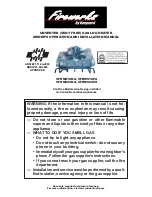
15
FIGURE 12. GAS PIPING WITH
FLEXIBLE CONNECTOR.
FIGURE 13. GAS PIPING WITH ALL
BLACK IRON PIPE TO GAS CONTROL.
SEDIMENT TRAPS
A sediment trap (dirt leg) shall be installed as close to the inlet of the
water heater as practical at the time of water heater installation. The
sediment trap shall be either a tee
fi
tting with a capped nipple in the
bottom outlet or other device recognized as an effective sediment
trap. If a tee
fi
tting is used, it shall be installed in conformance with
one of the methods of installation shown in Figures 12 and 13.
Contaminants in the gas lines may cause improper operation of
the gas control valve/thermostat and may result in
fi
re or explosion.
Before attaching the gas line, be sure that all gas pipe is clean on
the inside. To trap any dirt or foreign material in the gas supply line, a
sediment trap must be incorporated in the piping. The sediment trap
must be readily accessible. Install in accordance with the “Gas Piping”
section. Refer to the current edition of the National Fuel Gas Code,
ANSI Z223.1/NFPA 54.
FIGURE 14.
FILLING THE WATER HEATER
Never use this water heater unless it is completely full of water. To prevent
damage to the tank, the tank must be
fi
lled with water. Water must
fl
ow
from the hot water faucet before turning “ON” gas to the water heater.
To
fi
ll the water heater with water:
1. Close the water heater drain valve by turning the handle to the right
(clockwise). The drain valve is on the lower front of the water heater.
2. Open the cold water supply valve to the water heater.
NOTE: The cold water supply valve must be left open when
the water heater is in use.
3. To insure complete
fi
lling of the tank, allow air to exit by opening the
nearest hot water faucet. Allow water to run until a constant
fl
ow is
obtained. This will let air out of the water heater and the piping.
4. Check all water piping and connections for leaks. Repair as needed.
BLOWER ASSEMBLY INSTALLATION
SEQUENCE OF INSTALLATION
1. This power direct vent water heater comes with the blower
assembly installed.
2 After the unit is set in place, make sure the blower assembly is still
mounted securely, and make sure there is no damage to the blower.
3. Make sure there is no packing material in the discharge of the
blower or the intake, see Figure 15.
4. Make sure that the rubber tubing is still attached from the air
pressure switch to the port on the blower housing. Make sure
the rubber tubing is not folded anywhere between the pressure
switch and the blower housing.
5. Make sure the ON/OFF switch is in the OFF position and that
the wiring harness is connected from the blower control box
.
.
.
Summary of Contents for ProMax GPDX-50
Page 3: ...3...
Page 23: ...23...
Page 36: ...Copyright 2012 A O Smith Corporation All rights reserved...
















































